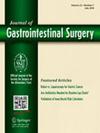克罗恩病保护切除术后的会阴伤口并发症:网膜蒂皮瓣的影响和返回手术室的预测因素。
IF 2.2
3区 医学
Q3 GASTROENTEROLOGY & HEPATOLOGY
引用次数: 0
摘要
背景:大网膜蒂皮瓣在降低克罗恩病会阴伤口并发症和术后盆腔脓肿风险中的作用尚不明确。本研究的目的是确定大网膜蒂皮瓣是否对需要返回手术室的会阴伤口并发症的发生率有任何影响,或者对克罗恩病行直肠切除术的患者进行盆腔脓肿放射引导引流的要求有任何影响。该研究包括克罗恩病原发会阴闭合伴或不伴大网膜蒂皮瓣的患者。主要观察指标为会阴伤口并发症返回手术室或需要放射引导引流盆腔脓肿。结果:219例患者(带皮瓣71例,不带皮瓣148例)在研究期间行了直肠切除术。在非计划返回手术室的比率(11.27% vs 9.46%, p=0.81)或需要放射引导下盆腔脓肿引流的患者数量(11.27% vs 6.76%, p=0.30)方面,两组之间没有差异。皮瓣组患者更有可能有吸烟史(p=0.02)、瘘管性肛周疾病史(p=0.01)、接受过括约肌外剥离(p=0.03)和手术时使用过切口伤口VACs (p=0.02)。结论:谨慎的患者选择大网膜蒂皮瓣可能起到减少伤口并发症的作用,其程度与低风险会阴伤口相似。本文章由计算机程序翻译,如有差异,请以英文原文为准。
Perineal wound complications after proctectomy for Crohn’s disease: the impact of the omental pedicle flap and predictors of return to the operating room
Background
The role of omental pedicle flaps (OPFs) in reducing the risk of perineal wound complications and postoperative pelvic abscesses in patients with Crohn’s disease remains unclear. This study aimed to determine whether OPFs had any effect on the incidence of perineal wound complications requiring a return to the operating room (OR) or the requirement for radiologic-guided drainage of pelvic abscesses in patients with Crohn’s disease who underwent proctectomy.
Methods
This was a retrospective, single-center study. The study included patients who underwent proctectomy for Crohn’s disease with primary perineal closure, with or without an OPF. The primary outcome measures were return to the OR for perineal wound complications or the requirement for radiologically guided drainage of pelvic abscesses.
Results
A total of 219 patients (71 with flap and 148 without flap) underwent proctectomy during the study period. No differences were observed in the rate of unplanned return to the OR (11.27% in the OPF group vs 9.46% in the non-OPF group; P =.81) or the number of patients requiring radiologically guided drainage of pelvic abscesses (11.27% in the OPF group vs 6.76% in the non-OPF group, respectively; P =.30) between the cohorts. Patients in the flap cohort were more likely to have a history of tobacco use (P =.02), fistulizing perianal disease (P =.01), undergo extrasphincteric dissection (P =.03), and use incisional wound vacuum assisted closure (VAC) at the time of surgery (P =.02).
Conclusion
Careful patient selection for the OPF might play a role in reducing wound complications to a level similar to that observed in patients with lower-risk perineal wounds.
求助全文
通过发布文献求助,成功后即可免费获取论文全文。
去求助
来源期刊
CiteScore
5.50
自引率
3.10%
发文量
319
审稿时长
2 months
期刊介绍:
The Journal of Gastrointestinal Surgery is a scholarly, peer-reviewed journal that updates the surgeon on the latest developments in gastrointestinal surgery. The journal includes original articles on surgery of the digestive tract; gastrointestinal images; "How I Do It" articles, subject reviews, book reports, editorial columns, the SSAT Presidential Address, articles by a guest orator, symposia, letters, results of conferences and more. This is the official publication of the Society for Surgery of the Alimentary Tract. The journal functions as an outstanding forum for continuing education in surgery and diseases of the gastrointestinal tract.

 求助内容:
求助内容: 应助结果提醒方式:
应助结果提醒方式:


